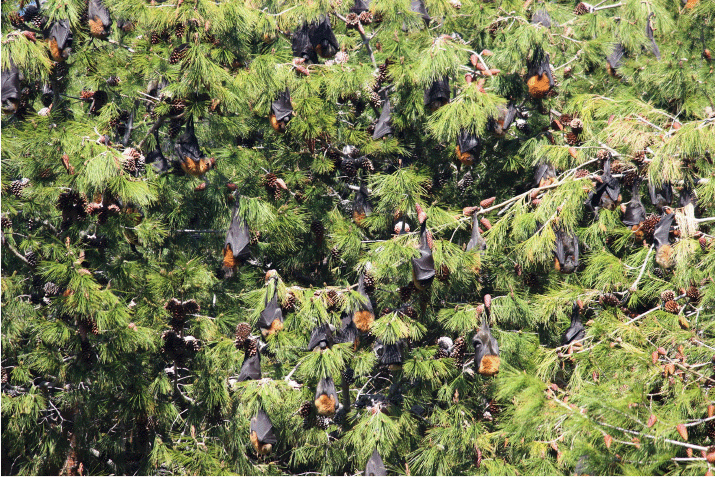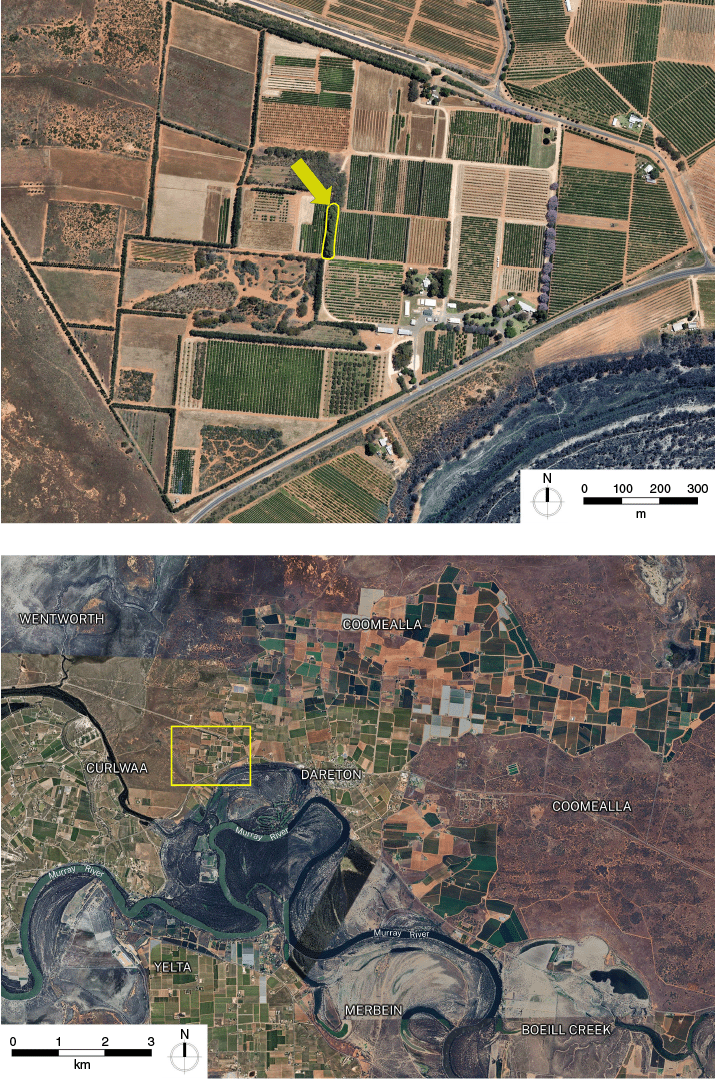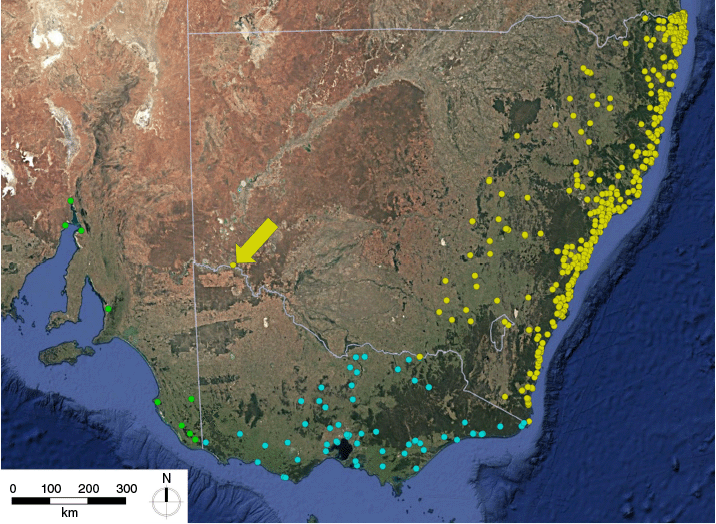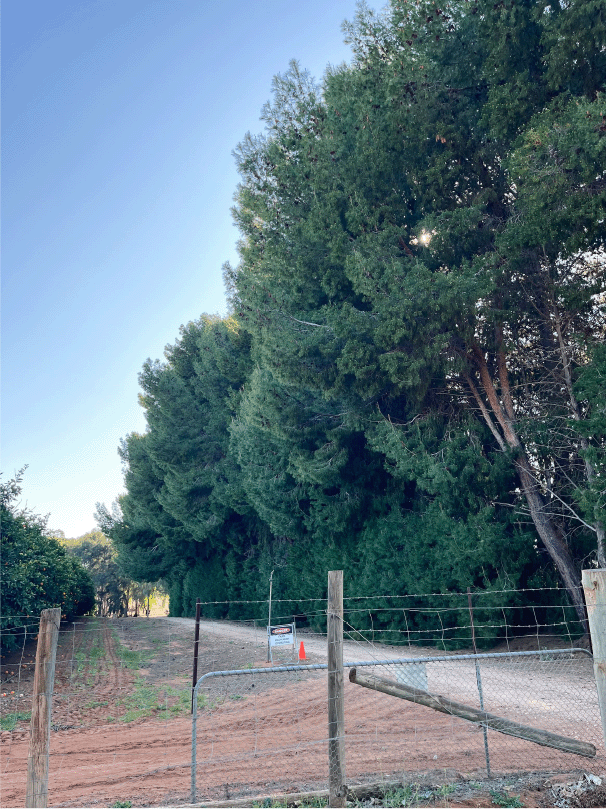The first confirmed grey-headed flying-fox (Pteropus poliocephalus) roost in western New South Wales, Australia
Matthew Mo A * , Troy Witte B , Trevor Bauer C , Ray Dayman C , Leila Brook D , Jason Van Weenen E and Sandra Guy F
A * , Troy Witte B , Trevor Bauer C , Ray Dayman C , Leila Brook D , Jason Van Weenen E and Sandra Guy F
A
B
C
D
E
F
Abstract
The grey-headed flying-fox (Pteropus poliocephalus) typically occurs within 300 km of the eastern and south-eastern Australian coastline from the mid-coast of Queensland to Adelaide, South Australia. We report the unprecedented occurrence of a grey-headed flying-fox colony in Curlwaa, a semi-arid town in New South Wales (NSW) more than 300 km from the nearest other known roost used by the species. Notably, the colony has been continually occupied since first forming in mid-July 2024, a period of 11 months to date. This roost represents the first confirmed grey-headed flying-fox roost anywhere in the western half of NSW and one of only three colonies of this species known to have persisted in a semi-arid region over a timeframe of months.
Keywords: Chiroptera, Far West region, flying-fox colony, Murray–Darling Basin, Old World fruit bats, Pteropodidae, range expansion, roosting ecology, Yinpterochiroptera.
Introduction
Bats are the only mammals capable of true flight, enabling them to disperse across large areas of foraging habitat and, in social species, regroup in roosting aggregations (Hall and Richards 2000; Kunz and Fenton 2005). In particular, for some of Australia’s flying-foxes, individuals have been recorded undertaking annual journeys of more than 1400 km and readily moving between large numbers of communal roosts (Welbergen et al. 2020). This scale of movement enables flying-fox species’ populations on the Australian mainland to be panmictic (Nelson 1965) and communal roosts having more than 10% of individuals turning over daily (Welbergen et al. 2020).
One of Australia’s endemic flying-fox species, the grey-headed flying-fox (Pteropus poliocephalus) has a distinctive geographical range as the worlds most southerly distributed megabat (family Pteropodidae). The species occurs from the mid-coast of Queensland to eastern South Australia, mostly within 300 km of the coast (Churchill 2008; Timmiss et al. 2021), reaching as far south as the southern Victorian coastline (Williams et al. 2006; Parris and Hazell 2005). Some vagrants have also been recorded crossing the Bass Strait into Tasmania (Driessen et al. 2011). Although individuals move throughout this range, the species as a whole displays high fidelity to established roost sites, where aggregations fluctuate upwards to the hundreds of thousands (Pierson and Raine 1992; Klose et al. 2009; Lunn et al. 2021).
Notably the western and southern extent of the grey-headed flying-fox’s geographical range is relatively recent. Prior to a communal roost establishing in Melbourne in 1981, grey-headed flying-foxes were only seasonal visitors to Victoria (Menkhorst and Dixon 1985). Similarly, the species was largely absent from South Australia until a communal roost formed in Adelaide in 2010 (Boardman 2021). Even within New South Wales (NSW), distributional shifts have been observed in grey-headed flying-foxes starting to occur as far inland as the North West Slopes (e.g. in Inverell and Gunnedah), Orana (e.g. in Dubbo), Central West (e.g. in Dubbo and Cowra), South West Slopes (e.g. in Young) and the Riverina (e.g. in Wagga Wagga and Albury) regions within the last two decades (Timmiss et al. 2021). This note reports on recent observations of a colony of grey-headed flying-foxes occurring much further inland in NSW than these previous locations.
Methods and results
In late June 2024, a flying-fox colony was identified by one of the authors (TW) within the Dareton Primary Industries Institute, a 243-ha state government-owned site managed by the NSW Department of Primary Industries in Curlwaa, Wentworth Shire, NSW (34.089638°S, 142.011519°E). The roost habitat comprised of a row of pine trees (Pinus spp.) stretching approximately 80 m in length (Fig. 1). The foliage is very dense, with only animals roosting in the outer foliage being visible. The area of the roost comprised approximately 1600 m2. Visual examinations showed that the colony comprised entirely of grey-headed flying-foxes (Fig. 2), based on observing distinguishing features such as the reddish-orange mantle completely encircling the neck and grey fur covering the head and legs (Churchill 2008; Tidemann et al. 2013). Although there is no water source at the immediate site, the Murray River is situated approximately 1.5 km south of the roost (Fig. 3).
Grey-headed flying-foxes visible in the outer foliage of pine trees. Photograph by Trevor Bauer.

The location of the grey-headed flying-fox roost within the Dareton Primary Industries Institute (top), and its location within the broader region (bottom).

The colony has been continually present from the time of establishment to the present day (current to the time of writing). On 9 August 2024, a ground count of all visible individuals undertaken by one of the authors (BT) recorded 871 individuals. If concealed animals were accounted for, colony size would likely be in the thousands of individuals. On 21 November 2024, a subsequent ground count of visible individuals by this author (BT) recorded only 67 individuals.
The NSW Department of Climate Change, Energy, the Environment and Water and the Victorian Department of Energy, Environment and Climate Action received some community reports of flying-foxes foraging in towns within 60 km of the roost. These reports indicated feeding in lemon-scented gums (Corymbia citriodora), California fan palms (Washingtonia filifera) and commercial citrus trees (Citrus spp.). One resident within 7 km of the roost reported nightly foraging in a lemon-scented gum for a period of weeks from mid-July to August 2024, with up to 11 individuals present at the same time during the peak of flowering (B. Behsmann, pers. comm, 1 October 2024).
Discussion
The establishment of a grey-headed flying-fox roost in Curlwaa represents the first confirmed grey-headed flying-fox roost in the Far West region of NSW, as well as the first roost of this species anywhere in the western half of NSW (Fig. 4). These inland regions are more typically home to the little red flying-fox (P. scapulatus), which occurs further inland than other Australian flying-fox species (Lumsden and Bennett 1995; Young and Ford 2000). In context with our current knowledge of grey-headed flying-fox roosts, Curlwaa is situated closer to known roosts in South Australia and Victoria than the nearest documented roost in NSW. Even so, there is more than 300 km of distance between Curlwaa and the next nearest grey-headed flying-fox roost (Fig. 4), with only 12 other grey-headed flying-fox roosts known to occur within 400 km (Table 1). All of these are South Australian and Victorian roosts, with the nearest NSW roost in Albury located approximately 500 km away.
Map showing the location of the new grey-headed flying-fox roost in Curlwaa in context with other known grey-headed flying-fox (Pteropus poliocephalus) roosts in New South Wales and the Australian Capital Territory (yellow circles), Victoria (blue circles) and South Australia (green circles).

| Roost location | Distance (km) | |
|---|---|---|
| Adelaide, South Australia | 326 | |
| Naracoorte, South Australia | 340 | |
| Bendigo, Victoria | 356 | |
| Maryborough, Victoria | 364 | |
| Kyabram, Victoria | 366 | |
| Nathalia, Victoria | 367 | |
| Wangolina, South Australia | 381 | |
| Castlemaine, Victoria | 381 | |
| Numurkah, Victoria | 383 | |
| Tatura, Victoria | 388 | |
| Port Pirie, South Australia | 388 | |
| Hamilton, Victoria | 399 |
The occurrence and persistence of a grey-headed flying-fox colony in Curlwaa is also significant considering the climate of the region. The Wentworth Shire is a semi-arid zone based on annual precipitation ranging from 200 to 400 mm (Kalma and Franks 2003), with the nearest weather station to Curlwaa (Wentworth Post Office weather station, 8.8 km from the roost) recording 253.5 mm annual precipitation for 2023 (Australian Bureau of Meteorology 2024). To date, the Curlwaa roost is one of only three grey-headed flying-fox roosts confirmed within semi-arid regions, with the other two situated in Port Augusta and Whyalla, both in South Australia (South Australian Department of Environment and Water, unpubl. data).
The discovery of this grey-headed flying-fox roost in far western NSW is a further development in a gradual southerly and westerly range expansion of the species. As mentioned earlier, observed roosting of grey-headed flying-foxes anywhere in South Australia and Victoria has only come about in the last two (Boardman 2021) and four decades (Menkhorst and Dixon 1985) respectively. Growing numbers of scientific studies have identified food availability as a major driver of flying-fox movements in certain areas (Parris and Hazell 2005; Yabsley et al. 2021) and in particular the reasons for individuals persisting in certain areas (Páez et al. 2018; Meade et al. 2021). Though anecdotal, community reports we received demonstrate some extent of fruiting and flowering of native and exotic diet species within nightly foraging distances of Curlwaa (80 km; Eby 1991; Field et al. 2016).
Management implications
Unprecedented occurrences of flying-foxes have potential management implications considering Australia’s long history of human-wildlife conflict associated with flying-foxes (Mo et al. 2023). These conflicts principally arise from communities feeling impacted by flying-fox roosts occurring close to human settlements (Mo et al. 2020; Smith and McManus 2024) and horticultural production losses associated with flying-foxes feeding on cultivated fruit crops (McClelland et al. 2011). The grey-headed flying-fox is particularly implicated with the broad overlap of the species’ geographical range with Australia’s most populous regions, including five capital cities (Currey et al. 2018; Timmiss et al. 2021). Although little red flying-foxes have occurred in the Far West region traditionally (Lumsden and Bennett 1995), they typically form more transient colonies rather than roosts that are continually occupied for long periods of time (months to years) as in the grey-headed flying-fox (Eby 1995). For the present Curlwaa roost, occurring on government-owned land and thus being distant from residential areas is probably a key factor in the roost having so far avoided being implicated in conflict situations with the general public.
Acknowledgements
Community reports provided anecdotal information on foraging activity in the surrounding region.
References
Australian Bureau of Meteorology. (2024). Climate data online. Available at http://www.bom.gov.au/climate/data/?ref¼ftr [accessed 1 December 2024]
Currey, K. C., Kendal, D., van der Ree, R., and Lentini, P. E. (2018). Land manager perspectives on conflict mitigation strategies for urban flying-fox camps. Diversity 10, 39.
| Crossref | Google Scholar |
Driessen, M., Brereton, R., and Pauza, M. (2011). Status and conservation of bats in Tasmania. In ‘The Biology and Conservation of Australasian Bats’. (Eds B. Law, P. Eby, D. Lunney, and L. Lumsden.) pp. 324–336. (Royal Zoological Society of NSW: Mosman, NSW.) 10.7882/FS.2011.033
Eby, P. (1991). Seasonal movements of grey-headed flying-foxes, Pteropus poliocephalus (Chiroptera: Pteropodidae), from two maternity camps in northern New South Wales. Wildlife Research 18, 547-559.
| Crossref | Google Scholar |
Field, H. E., Smith, C. S., de Jong, C. E., Melville, D., Broos, A., Kung, N., Thompson, J., and Dechmann, D. K. (2016). Landscape utilisation, animal behaviour and Hendra virus risk. EcoHealth 13, 26-38.
| Crossref | Google Scholar | PubMed |
Klose, S. M., Welbergen, J. A., Goldizen, A. W., and Kalko, E. K. V. (2009). Spatio-temporal vigilance architecture of an Australian flying-fox colony. Behavioral Ecology and Sociobiology 63, 371-380.
| Crossref | Google Scholar |
Lumsden, I. F., and Bennett, A. F. (1995). Bats of a semi-arid environment in south-eastern Australia: biogeography, ecology and conservation. Wildlife Research 22, 217-239.
| Crossref | Google Scholar |
Lunn, T. J., Eby, P., Brooks, R., McCallum, H., Plowright, R. K., Kessler, M. K., and Peel, A. J. (2021). Conventional wisdom on roosting behavior of Australian flying-foxes – a critical review, and evaluation using new data. Ecology and Evolution 11, 13532-13558.
| Crossref | Google Scholar | PubMed |
McClelland, K. L., Fleming, P. J. S., and Malcolm, P. J. (2011). Grey-headed flying-foxes in orchards: a collaborative project on damage estimates, contributing factors and mitigation strategies – triumphs and tribulations of flying-fox conservation and management in NSW. In ‘The Biology and Conservation of Australasian Bats’. (Eds B. Law, P. Eby, D. Lunney, and L. Lumsden.) pp. 391–398. (Royal Zoological Society of NSW: Mosman, NSW.) 10.7882/FS.2011.040.
Meade, J., Martin, J. M., and Welbergen, J. A. (2021). Fast food in the city? Nomadic flying-foxes commute less and hang around for longer in urban areas. Behavioral Ecology 32, 1151-1162.
| Crossref | Google Scholar |
Menkhorst, P. W., and Dixon, J.M. (1985). Influxes of the grey-headed flying fox Pteropus poliocephalus (Chiroptera, Pteropodidae) to Victoria in 1981 and 1982. Australian Mammalogy 8, 117-121.
| Crossref | Google Scholar |
Mo, M., Roache, M., and Demers, M. A. (2020). Reducing human-wildlife conflict through subsidizing mitigation equipment and services: helping communities living with the gray-headed flying-fox. Human Dimensions of Wildlife 25, 387-397.
| Crossref | Google Scholar |
Mo, M., Coutts-McClelland, K., Wilson, V., Haering, R., Oliver, L., Bell, L., and Lunney, D. (2023). Managing the grey-headed flying-fox as a threatened species in New South Wales two decades on: contentious issues for horticulturalists and communities. Australian Zoologist 42, 871-896.
| Crossref | Google Scholar |
Nelson, J. E. (1965). Movements of Australian flying foxes (Pteropodidae: Megachiroptera). Australian Journal of Zoology 13, 53-74.
| Crossref | Google Scholar |
Páez, D. J., Restif, O., Eby, P., and Plowright, R. K. (2018). Optimal foraging in seasonal environments: implications for residency of Australian flying foxes in food-subsidized urban landscapes. Philosophical Transactions of the Royal Society B 373, 20170097.
| Crossref | Google Scholar | PubMed |
Parris, K. M., and Hazell, D. L. (2005). Biotic effects of climate change in urban environments: the case of the grey-headed flying-fox (Pteropus poliocephalus) in Melbourne, Australia. Biological Conservation 124, 267-276.
| Crossref | Google Scholar |
Pierson, E. D., and Raine, W. E. (1992). The biology of flying foxes of the genus Pteropus: a review. In ‘Pacific Island Flying Foxes: Proceedings of An International Conservation Conference, Vol. 90’. (Eds D. E. Wilson, and G. L. Graham.) pp. 1–17. (US Department of the Interior Fish and Wildlife Service: Washington, DC.)
Smith, P., and McManus, P. (2024). Geographies of coexistence: negotiating urban space with the grey-headed flying-fox. Australian Geographer 55, 95-114.
| Crossref | Google Scholar |
Timmiss, L. A., Martin, J. M., Murray, N. J., Welbergen, J. A., Westcott, D., McKeown, A., and Kingsford, R. T. (2021). Threatened but not conserved: flying-fox roosting and foraging habitat in Australia. Australian Journal of Zoology 68, 226-233.
| Crossref | Google Scholar |
Welbergen, J. A., Meade, J., Field, H.E., Edson, D., McMichael, L., Shoo, L.P., Praszczalek, J., Smith, C., and Martin, J.M. (2020). Extreme mobility of the world’s largest flying mammals creates key challenges for management and conservation. BMC Biology 18, 101.
| Crossref | Google Scholar | PubMed |
Williams, N. S. G., McDonnell, M. J., Phelan, G. K., Keim, L. D., and van der Ree, R. (2006). Range expansion due to urbanisation: increased food resources attract grey-headed flying-foxes (Pteropus poliocephalus) to Melbourne. Austral Ecology 31, 190-198.
| Crossref | Google Scholar |
Yabsley, S. H., Meade, J., Martin, J. M., and Welbergen, J. A. (2021). Human-modified landscapes provide key foraging areas for a threatened flying mammal: the grey-headed flying-fox. PLoS One 16, e0259395.
| Crossref | Google Scholar | PubMed |
Young, R. A., and Ford, G. I. (2000). Bat fauna of a semi-arid environment in central western Queensland, Australia. Wildlife Research 27, 203-215.
| Crossref | Google Scholar |



